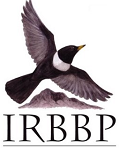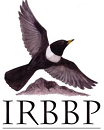
Great Spotted Woodpecker
Dendrocopos major
Mórchnagaire breac
Status All Ireland: Breeding, expanding distribution
Population estimate all Ireland: 50 – 100 pairs
Trend (12 years): Increase
Trend (40 years): Increase
Survey timing: April to June
Habitat: Woodland
Occurrence: Recent colonist. Breeding still confined to eastern counties.
Habitat preference (simple description of preferred nesting habitat): Woodland – especially mature oak or other, mixed broad-leaf species – best where there is much standing deadwood. Also: 1) Birch and willow swamp scrub 2) Mature commercial coniferous plantations – particularly with standing dead stumps 3) Small copses of mixed trees including Scots pine in open country / farmland. All mostly in lowland areas.
Preferred ways to establish breeding status: Listen for drumming, especially early in season (mid-Jan to end March) during first two hours of daylight to establish presence of birds. Look for distinctive feeding signs on dead wood and old nest holes. Nest is excavated in trunk or bough – usually in dead wood – over a three-week period. Several subsequent visits may be required to confirm breeding. Adults secretive during incubation. Occupied nests most easily found when adults feeding young (roughly 3rd week May to 2nd week June). Much activity back and forth to nest. Chicks noisy in nest, especially in the last two of their three weeks fledging. Fledged juveniles hard to locate in the field (stay high in canopy) but increasingly, juveniles (with striking red crown) being recorded at garden feeders – usually from 3rd week June onwards (red crown retained till approx Oct). Currently with expanding distribution – surveys should be prioritised in suitable habitat within neighbouring counties.


